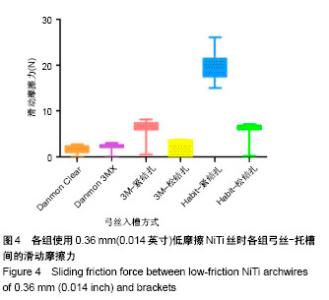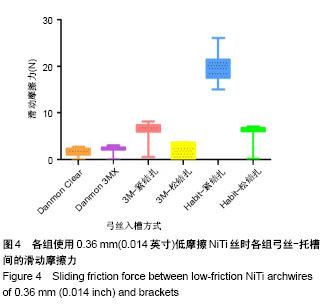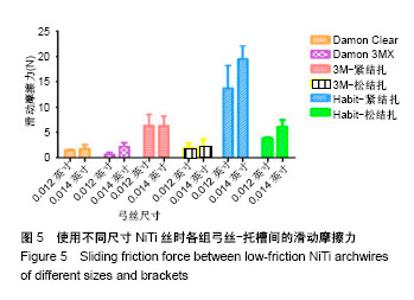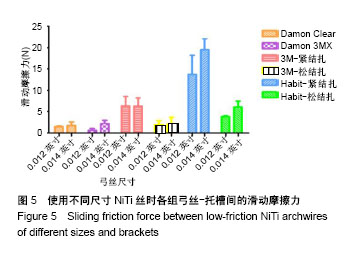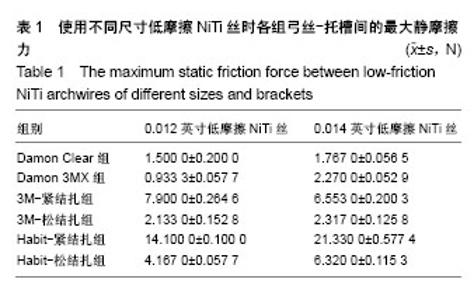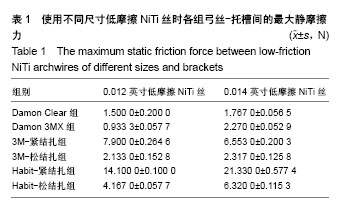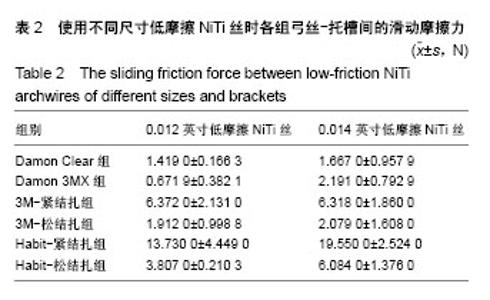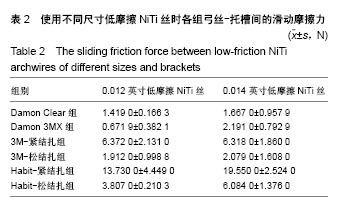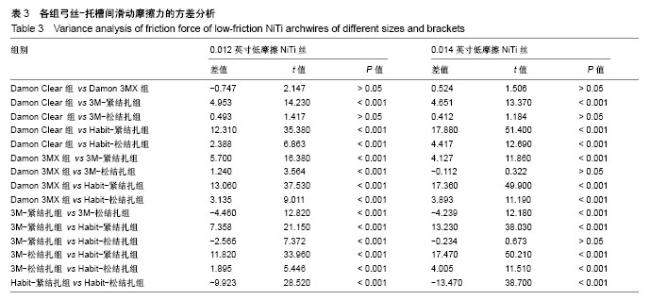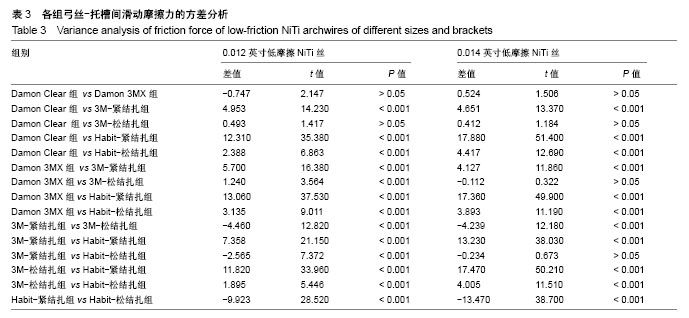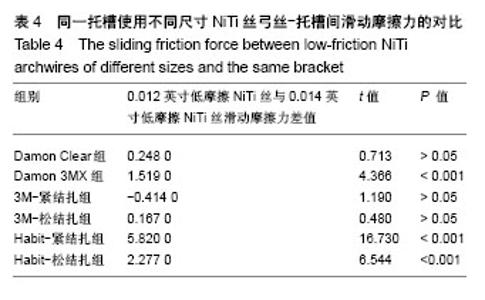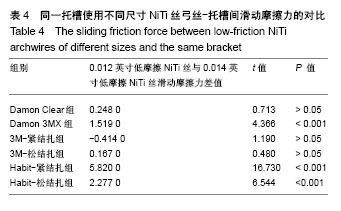Chinese Journal of Tissue Engineering Research ›› 2018, Vol. 22 ›› Issue (18): 2860-2865.doi: 10.3969/j.issn.2095-4344.0884
Previous Articles Next Articles
Frictional resistance of archwires with various ligations in alignment phase
Zhang Ming-can1, Ma Xiao-zhou2, Wu Jie2, Zhao Wei2, Sun Hai-yuan1, Zhao Yi-song1
- 1Tanggu Stomatological Hospital, Tianjin 300450, China; 2Stomatological Hospital of Tianjin Medical University, Tianjin 300070, China
-
Received:2018-05-13Online:2018-06-28Published:2018-06-28 -
About author:Zhang Ming-can, Master, Associate chief physician, Tanggu Stomatological Hospital, Tianjin 300450, China -
Supported by:the Science and Technology Project funded by the Health Department of Tianjin Binhai New District, No. 2013Bwky023; the Science and Technology Research Fund of the Stomatological Hospital of Tianjin Medical University, No. 2014YKYQ02
CLC Number:
Cite this article
Zhang Ming-can, Ma Xiao-zhou, Wu Jie, Zhao Wei, Sun Hai-yuan, Zhao Yi-song. Frictional resistance of archwires with various ligations in alignment phase[J]. Chinese Journal of Tissue Engineering Research, 2018, 22(18): 2860-2865.
share this article
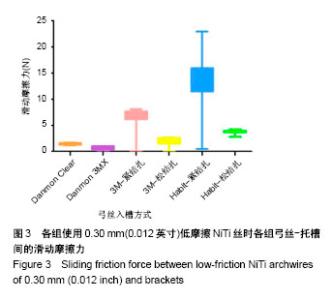
不同托槽与弓丝组合的摩擦力值如图3-5所示。每组测量项目为最大静摩擦力和滑动摩擦力,数据精确度为 0.000 1 N。此次研究为提高组间可比性,所采用的测试弓丝为0.30 mm(0.012英寸)、0.36 mm(0.014英寸)低摩擦NiTi弓丝,不仅同一弓丝与不同托槽间具有对比价值,而且同一托槽与不同弓丝间的数值也具有可比性。 实验选择中度拥挤病例,牙齿和托槽间较宽松,牙齿移动时经典摩擦力以滑动摩擦力表现[7],故选取滑动摩擦力进行多组间统计分析,有如下结果:①当使用0.30 mm (0.012英寸)低摩擦NiTi丝时,在不同材料托槽或不同结扎方式中的摩擦力两两比较差异均有显著性意义(P < 0.05),但要除过Damon Clear与3M-松结扎组、Damon CLear组与Damon 3MX组的比较;②当使用0.36 mm(0.014英寸)NiTi丝时,3M-松结扎组与Damon 3MX组、3M-紧结扎组与Habit-松结扎组、Damon Clear组与3M-松结扎组的摩擦力比较无差异(P > 0.05),3M-松结扎组、Damon Clear组、Damon 3MX组3者间的摩擦力相似;③当使用0.30 mm (0.012英寸)低摩擦NiTi丝入槽时,Damon Clear组的摩擦力值略大于Damon 3MX托槽,但组间不显著(P < 0.05);当使用0.36 mm(0.014英寸)低摩擦NiTi丝入槽时,Damon Clear组与Damon 3MX组的摩擦力比较无差异(P > 0.05);④在Damon Clear托槽、3M传统金属托槽紧结扎和松结扎中,两种弓丝间的摩擦力比较无明显差异(P > 0.05);在Damon 3MX金属自锁托槽、Habit传统单晶体托槽紧结扎和松结扎中,两种弓丝间的摩擦力比较差异有显著性意义(P < 0.001),见表1-4。 "
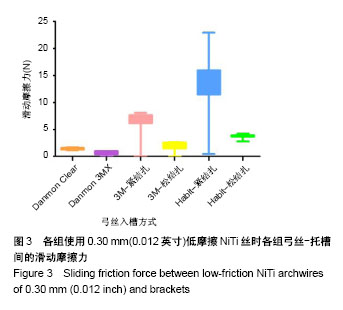
| [1] Proffit WR,Field HW.Contemporary Orthodontics.3rd ed. St.Louis:Mosby,2000:343-349.[2] Franco DJ,Spiller RE,Fraunhofer JA.Frictional resistances using Teflon-coated ligatures with various bracker-archwire combinations. Angle Orthod.1995;65(1):63-65.[3] 白雪芹,曾祥龙.低摩擦结扎圈在牙齿排齐阶段静摩擦力的实验研究[J].口腔正畸学,2008,15(2):78-80.[4] 张丽雯,宋立滨,张瑾,等.不同托槽与弓丝组合滑动摩擦力的实验研究[J].中华口腔正畸学杂志,2017,24(1):10-13.[5] Montasser MA,Keilig L,El-Bialy T,et al.Effect of archwire cross-section changes on force levels during complex tooth alignment with conventional and self-ligating brackets.Am J Orthod Dentofacial Orthop.2015;147(4):S101-S108.[6] 张明灿,赵丽丽,孙海媛,等.不锈钢结扎丝松结扎法在口腔正畸固定矫治术中的应用体会[J].山东医药,2015,55(26):106-107.[7] 林新平.临床口腔正畸生物力学机制解析[M].北京:人民卫生出版社, 2012: 106.[8] Li Y,Jacox LA,Little SH,et al.Orthodontic tooth movement:The biology and clinical implications.Kaohsiung J Med Sci. 2018;34(4):207-214..[9] 任庆源,齐慧川,胡敏.不同种类初始弓丝对正畸治疗影响的研究进展[J].吉林大学学报(医学版),2015,41(4):874-876.[10] Higa RH,Henriques JFC,Janson G,et al. Force level of small diameter nickel-titanium orthodontic wires ligated with different methods. Prog Orthod.2017;18(1):21.[11] Thorstenson GA,Kusy RP.Comparison of resistance to sliding between different self-ligating brackets with second-order angulation in the dry and saliva states.Am J Orthod Dentofacial Orthop. 2002;121(5): 472-482.[12] Henao SP,Kusy RP.Evaluation of the frictional resistance of conventional and self-ligating bracket designs using standardized archwires and dental typodonts.Angle Orthod. 2004; 74(2):202-211.[13] Ding SH,Cai P.Study on the Frictional Resistance of Selfligating Bracket versus Conventional Bracket.J Oral Sci Res. 2008;24(4): 420-423.[14] Kim TK,Kim KD,Baek SH.Comparison of frictional forces during the initial leveling stage in various combinations of selfligating brackets and archwires with a custom-designed typodont system.Am J Orthod Dentofacial Orthop. 2008;133(2):187e15-24.[15] Cordasco G,Lo GA,Militi A,et al.In vitro evaluation of resistance to sliding in self-ligating and conventional bracket systems during dental alignment.Korean J Orthodont. 2012;42(4):218-224.[16] Gandini P,Orsi L,Bertoncini C,et al.In vitro frictional forces generated by three different ligation methods.Angle Orthodontist.2008;78(5):917.[17] Queiroz GV,Ballester RY,Paiva JBD,et al.Comparative study of frictional forces generated by NiTi archwire deformation in different orthodontic brackets: In vitro evaluation Estudo comparativo da força de atrito produzida pela deformação de arco NiTi em diferentes braquetes ortodônticos: aval.Dent Press J Orthodont. 2012;17(4):45-50.[18] Khambay B,Millett D,Mchugh S.Archwire seating forces produced by different ligation methods and their effect on frictional resistance.Eur J Orthodont.2005;27(3):302.[19] Hain M,Dhopatkar A,Rock P.The effect of ligation method on friction in sliding mechanics.Am J Orthod Dentofacial Orthop.2003;123(4): 416-422.[20] 张媛媛.不同弓丝—结扎方式摩擦力的实验研究[D].青岛大学, 2010.[21] 何平,宋锦璘,任劲松,等.不同种类固定矫治器在切牙排齐初始阶段的摩擦力对比研究[J].成都医学院学报,2016,11(3):334-337.[22] 白雪芹,曾祥龙.不同自锁托槽系统在牙齿排齐阶段摩擦力的对比实验研究[J].中华口腔正畸学杂志, 2007,14(3):131-134.[23] 胡昊,白玉兴.口内直接扫描技术的研究进展[J].中华口腔正畸学杂志, 2014,21(1):40-42.[24] Tavares A,Braga E,Araújo TMD,et al.Digital models: How can dental arch form be verified chairside?Dent Press J Orthodont. 2017;22(6):68-73.[25] Darroudi AM,Kuijpersjagtman AM,Ongkosuwito EM,et al.Accuracy of a computed tomography scanning procedure to manufacture digital models.Am J Orthod Dentofacial Orthop.2017;151(5):995-1003.[26] Majstorovic N,Zivkovic S,Glisic B.The advanced model definition and analysis of orthodontic parameters on 3D digital models.Srpski Arhiv Za Celokupno Lekarstvo. 2017;145(11-12):11-11.[27] Alcan T,Ceylano?lu C,Baysal B.The relationship between digital model accuracy and time-dependent deformation of alginate impressions. Angle Orthodontist.2009;79(1):30-36.[28] Torassian G,Kau CH,English JD,et al.Digital models vs plaster models using alginate and alginate substitute materials. Angle Orthodontist. 2010;80(4):474-481.[29] 李晶,王硕,张达,等.口内扫描数字化模型与硅橡胶制取石膏模型测量的对比研究[J].中华口腔正畸学杂志,2013,20(3):163-166.[30] 冯全胜,马笮,徐文秀,等.口腔3D打印模型与传统石膏模型精确性对比研究[J].中国老年保健医学, 2015,13(3):80-81.[31] Dawood A,Marti BM,Sauret-Jackson V,et al.3D printing in dentistry.Br Dent J. 2015;219(11):521-529.[32] Wesemann C,Muallah J,Mah J,et al.Accuracy and efficiency of full-arch digitalization and 3D printing: A comparison between desktop model scanners, an intraoral scanner, a CBCT model scan, and stereolithographic 3D printing. Quintessence Int.2017;48(1):41-50.[33] 孙成,于金华. 3D打印技术在口腔临床的应用[J].口腔生物医学, 2014, 5(1):49-52.[34] 刘玉,王培军,周珊,等.自锁托槽与传统托槽对比研究的进展与方向[J].中国组织工程研究,2014,18(25):4068-4072.[35] 刘松英,房伯君,王霞.正畸托槽材料及其相关性能的研究进展[J].辽宁医学杂志,2006,20(2):114-115.[36] Thorstenson GA,Kusy RP.Effect of archwire size and material on the resistance to sliding of self-ligating brackets with second—order angulation in the dry state.Am J Orthod Dentofacial Orthop. 2002; 122(3):295-305.[37] 张明灿,李洪发,武杰,等.松结扎在正畸排齐阶段的初步研究[J].中国美容医学,2014,23(8):655-658.[38] Miles PG. Self-ligating vs conventional twin brackets during en-masse spaceclosure with sliding mechanics. Am J Orthod Dentofacial Orthop. 2007;132(2):223-225.[39] Cobb NW,Kula KS,Philips C,et al.Efficiency of mutristrand steel,superalastic Ni-Ti and ion-implanted NiTi archwires for initial alignmet.Clin orthod Res.1998;1(1):12-19.[40] Kusy RP.Whitley JQ.Friction between different wire.bracket configurations and materiMs.Semin Orthod. 1997;3(3):166-177. |
| [1] | Zhang Tongtong, Wang Zhonghua, Wen Jie, Song Yuxin, Liu Lin. Application of three-dimensional printing model in surgical resection and reconstruction of cervical tumor [J]. Chinese Journal of Tissue Engineering Research, 2021, 25(9): 1335-1339. |
| [2] | Zeng Yanhua, Hao Yanlei. In vitro culture and purification of Schwann cells: a systematic review [J]. Chinese Journal of Tissue Engineering Research, 2021, 25(7): 1135-1141. |
| [3] | Xu Dongzi, Zhang Ting, Ouyang Zhaolian. The global competitive situation of cardiac tissue engineering based on patent analysis [J]. Chinese Journal of Tissue Engineering Research, 2021, 25(5): 807-812. |
| [4] | Wu Zijian, Hu Zhaoduan, Xie Youqiong, Wang Feng, Li Jia, Li Bocun, Cai Guowei, Peng Rui. Three-dimensional printing technology and bone tissue engineering research: literature metrology and visual analysis of research hotspots [J]. Chinese Journal of Tissue Engineering Research, 2021, 25(4): 564-569. |
| [5] | Chang Wenliao, Zhao Jie, Sun Xiaoliang, Wang Kun, Wu Guofeng, Zhou Jian, Li Shuxiang, Sun Han. Material selection, theoretical design and biomimetic function of artificial periosteum [J]. Chinese Journal of Tissue Engineering Research, 2021, 25(4): 600-606. |
| [6] | Liu Fei, Cui Yutao, Liu He. Advantages and problems of local antibiotic delivery system in the treatment of osteomyelitis [J]. Chinese Journal of Tissue Engineering Research, 2021, 25(4): 614-620. |
| [7] | Li Xiaozhuang, Duan Hao, Wang Weizhou, Tang Zhihong, Wang Yanghao, He Fei. Application of bone tissue engineering materials in the treatment of bone defect diseases in vivo [J]. Chinese Journal of Tissue Engineering Research, 2021, 25(4): 626-631. |
| [8] | Zhang Zhenkun, Li Zhe, Li Ya, Wang Yingying, Wang Yaping, Zhou Xinkui, Ma Shanshan, Guan Fangxia. Application of alginate based hydrogels/dressings in wound healing: sustained, dynamic and sequential release [J]. Chinese Journal of Tissue Engineering Research, 2021, 25(4): 638-643. |
| [9] | Chen Jiana, Qiu Yanling, Nie Minhai, Liu Xuqian. Tissue engineering scaffolds in repairing oral and maxillofacial soft tissue defects [J]. Chinese Journal of Tissue Engineering Research, 2021, 25(4): 644-650. |
| [10] | Xing Hao, Zhang Yonghong, Wang Dong. Advantages and disadvantages of repairing large-segment bone defect [J]. Chinese Journal of Tissue Engineering Research, 2021, 25(3): 426-430. |
| [11] | Chen Siqi, Xian Debin, Xu Rongsheng, Qin Zhongjie, Zhang Lei, Xia Delin. Effects of bone marrow mesenchymal stem cells and human umbilical vein endothelial cells combined with hydroxyapatite-tricalcium phosphate scaffolds on early angiogenesis in skull defect repair in rats [J]. Chinese Journal of Tissue Engineering Research, 2021, 25(22): 3458-3465. |
| [12] | Wang Hao, Chen Mingxue, Li Junkang, Luo Xujiang, Peng Liqing, Li Huo, Huang Bo, Tian Guangzhao, Liu Shuyun, Sui Xiang, Huang Jingxiang, Guo Quanyi, Lu Xiaobo. Decellularized porcine skin matrix for tissue-engineered meniscus scaffold [J]. Chinese Journal of Tissue Engineering Research, 2021, 25(22): 3473-3478. |
| [13] | Mo Jianling, He Shaoru, Feng Bowen, Jian Minqiao, Zhang Xiaohui, Liu Caisheng, Liang Yijing, Liu Yumei, Chen Liang, Zhou Haiyu, Liu Yanhui. Forming prevascularized cell sheets and the expression of angiogenesis-related factors [J]. Chinese Journal of Tissue Engineering Research, 2021, 25(22): 3479-3486. |
| [14] | Liu Chang, Li Datong, Liu Yuan, Kong Lingbo, Guo Rui, Yang Lixue, Hao Dingjun, He Baorong. Poor efficacy after vertebral augmentation surgery of acute symptomatic thoracolumbar osteoporotic compression fracture: relationship with bone cement, bone mineral density, and adjacent fractures [J]. Chinese Journal of Tissue Engineering Research, 2021, 25(22): 3510-3516. |
| [15] | Liu Liyong, Zhou Lei. Research and development status and development trend of hydrogel in tissue engineering based on patent information [J]. Chinese Journal of Tissue Engineering Research, 2021, 25(22): 3527-3533. |
| Viewed | ||||||
|
Full text |
|
|||||
|
Abstract |
|
|||||
